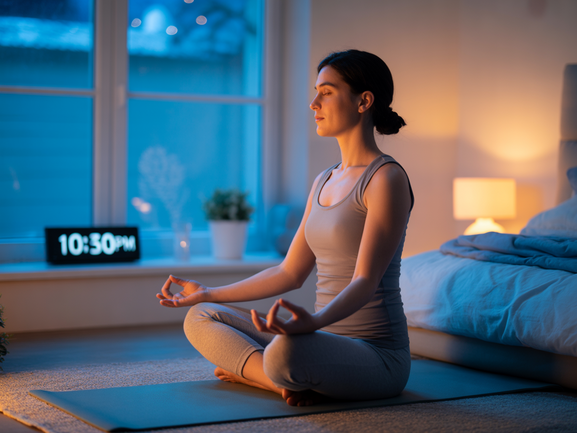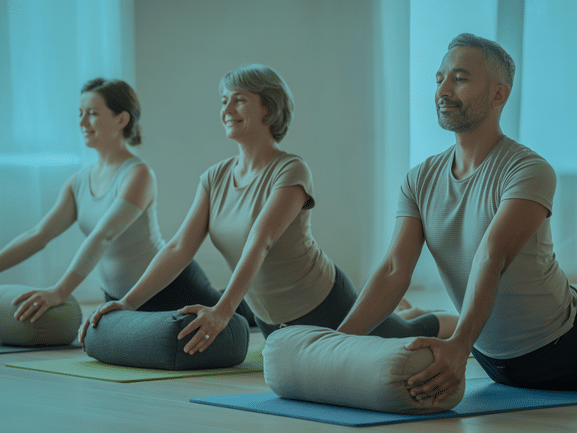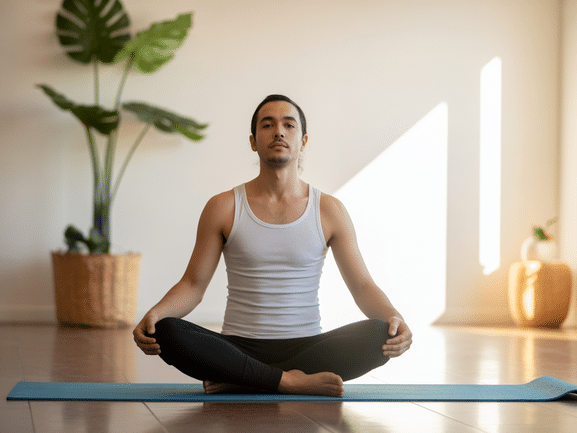Yoga for Insomnia: Your Guide to Restful Sleep

Tossing and turning, counting sheep, staring at the ceiling… does this sound familiar? If you’re one of the millions of people struggling with sleepless nights, you know the deep frustration of insomnia. But what if the solution wasn’t in a pill, but on a mat? A simple, nightly practice of yoga for insomnia could be the key to unlocking the deep, restorative sleep you crave.
This comprehensive guide provides a practical, science-backed approach to using yoga for insomnia. We’ll explore why it works, show you how to build a consistent practice, and offer a detailed routine you can begin tonight. Get ready to break the cycle of sleeplessness and wake up feeling truly refreshed and energized.
Understanding the Vicious Cycle of Insomnia
Insomnia is far more than just one bad night’s sleep. It’s a debilitating cycle of stress and sleeplessness that degrades your quality of life, affecting everything from your mood and cognitive function to your physical health. The cruel irony is that the more you worry about not sleeping, the more elusive sleep becomes. It’s a frustrating loop, but the good news is, you can break free.
This cycle is primarily fueled by a state of hyperarousal in the nervous system. When your mind is racing with anxious thoughts and your body is tense, it’s physiologically impossible to drift off. This is where a targeted yoga for insomnia routine becomes a powerful tool, directly counteracting this state of high alert.
The Science of How Yoga for Insomnia Improves Sleep
The effectiveness of yoga for insomnia is rooted in its ability to shift your body’s internal state. It’s not just about stretching; it’s a holistic practice that regulates the systems controlling your sleep-wake cycle.
- Calming the Nervous System: Yoga activates the parasympathetic nervous system—your body’s “rest and digest” mode. This actively counters the “fight or flight” response of the sympathetic nervous system that keeps you awake. Deep, mindful breathing (pranayama) is a cornerstone of this process.
- Hormonal Regulation: Chronic stress leads to elevated levels of cortisol, a hormone that promotes alertness. Studies show that a regular yoga practice helps reduce cortisol levels in the evening. Simultaneously, it can boost the production of melatonin, the key hormone that signals to your body it’s time for sleep.
- Increasing GABA Levels: Research has indicated that yoga can increase levels of Gamma-aminobutyric acid (GABA), a neurotransmitter that has a calming effect on the brain. Low GABA levels are often associated with anxiety and sleep disorders.
“A 2025 meta-analysis published in the Journal of Clinical Sleep Medicine found that yoga is a promising treatment for insomnia, with 75% of studies showing significant improvements in sleep quality and duration.”
How to Start Your Yoga for Insomnia Practice Today
Consistency is more important than intensity. For the next seven days, we challenge you to dedicate just 15-20 minutes each evening to a simple yoga for insomnia routine. Each day focuses on a new theme to progressively release tension and quiet the mind. These poses are gentle and accessible to all levels.
Your 7-Day Path to Better Sleep:
- Day 1: Releasing the Day – Neck and Shoulder Stretches: We hold so much of our daily stress in our neck and shoulders. Gentle rolls and stretches here signal to the body that the day is done and it’s safe to relax.
- Day 2: Calming the Mind – Seated Forward Folds: Folding inward is an act of introspection and surrender. These poses calm the nervous system and gently stretch the hamstrings and spine, common areas of tightness.
- Day 3: Ultimate Relaxation – Legs-Up-the-Wall Pose: This powerful restorative pose, Viparita Karani, helps reduce inflammation, improve circulation, and offers a profound sense of calm with minimal effort. It’s a top-tier pose in any yoga for insomnia sequence.
- Day 4: Mobilizing the Spine – Cat-Cow Pose: A tense spine can disrupt sleep. The gentle, flowing movement of Cat-Cow (Marjaryasana-Bitilasana) releases tension along the entire spinal column, promoting ease.
- Day 5: Soothing the Self – Child’s Pose: Balasana, or Child’s Pose, is a grounding posture that quiets the mind and gently stretches the back and hips. It fosters a feeling of safety and security.
- Day 6: Aiding Digestion – Supine Twists: A gentle spinal twist can aid digestion and release lower back tension, two factors that can interfere with comfortable rest.
- Day 7: Deep Surrender – Guided Body Scan Meditation (Savasana): The final day integrates everything with a guided meditation in Corpse Pose, training the mind to let go of lingering thoughts and fully surrender to sleep.
🎯 **Ready to start?** You can find guided versions of these routines, specifically designed for beginners, in the Vitalizen App.
The Best Yoga Poses for Insomnia
Here is a detailed breakdown of the most effective yoga poses for combating insomnia. We’ve included their benefits and how to practice them for maximum effect.
| Pose Name | Primary Benefit | Recommended Hold Time |
|---|---|---|
| Legs-Up-the-Wall (Viparita Karani) | Calms the nervous system, reduces leg fatigue, and alleviates lower back tension. An essential pose for any yoga for insomnia practice. | 5-15 minutes |
| Child’s Pose (Balasana) | Gently stretches the back, hips, and shoulders while quieting the mind. Fosters a sense of peace and surrender. | 3-5 minutes |
| Cat-Cow Pose (Marjaryasana-Bitilasana) | Increases spinal flexibility, relieves tension in the back and neck, and links breath with movement to calm the mind. | 10-15 rounds |
| Supine Spinal Twist (Supta Matsyendrasana) | Improves digestion, hydrates the spinal discs, and provides a gentle, restorative stretch for the entire back. | 2-3 minutes per side |
Beyond the Mat: Creating a Sleep-Supportive Environment
Your yoga for insomnia practice is most effective when paired with a sleep-friendly environment. Think of your bedroom as a sanctuary for rest.
- Dim the Lights: An hour before bed, lower the lights to signal melatonin production. Avoid the blue light from phones and screens, as it actively inhibits this process.
- Cool the Temperature: A cool room (around 65°F or 18°C) is proven to be more conducive to deep sleep.
- Minimize Noise: Ensure your room is quiet. If external noise is an issue, consider earplugs or a white noise machine.
- Optimize Comfort: Your bed, pillows, and bedding should be comfortable and supportive. This is a critical component of your sleep hygiene.
What to Expect: Realistic Timelines and Results
While some people feel an immediate benefit from their first session of yoga for insomnia, for others, the effects are cumulative. Be patient with yourself. The goal is not to force sleep but to create the ideal conditions for it to arise naturally. Most individuals report noticeable improvements in their ability to fall asleep and stay asleep within one to two weeks of consistent nightly practice. The key is to make it a non-negotiable ritual, just like brushing your teeth.
How Much Does Yoga for Insomnia Cost?
One of the greatest benefits of using yoga to improve your sleep is its accessibility. It can be completely free. However, for a more structured and supportive experience, you might consider:
- Yoga Apps: Apps like Vitalizen offer specialized yoga for insomnia programs for a monthly subscription, typically ranging from $10-$20.
- Local Studios: A drop-in restorative yoga class can cost between $15-$25.
- Online Courses: In-depth online courses on yoga for sleep can range from $50-$200.
The return on investment—improved health, productivity, and well-being—is truly priceless.
Join the Community and Share Your Journey
You’re not alone in this! We encourage you to share your progress and connect with others in our community. Leave a comment below. How is your yoga for insomnia challenge going? Did you discover a favorite pose? Your story could be the inspiration someone else needs to start their own journey to better sleep.
“I’ve been using the Vitalizen app for a few weeks now, and the sleep-focused yoga classes have been a game-changer. I fall asleep faster and wake up feeling more refreshed than I have in years.” – A Vitalizen User
Ready to Take the Next Step?
This guide is just the beginning. If you’re ready to dive deeper and build a transformative sleep routine, we invite you to explore the Vitalizen App | Yoga + Meditation. Our app is filled with a wide variety of sleep-focused classes, guided meditations, and calming soundscapes to help you create a personalized bedtime routine that works for you.
Start Your Journey to Better Sleep Now
Frequently Asked Questions About Yoga for Insomnia
How does yoga help with insomnia?
Yoga helps with insomnia by calming the nervous system, reducing stress and anxiety, and promoting the release of melatonin, the hormone that regulates sleep. The gentle stretches and mindful breathing techniques used in a yoga for insomnia routine can help to quiet the mind and prepare the body for rest. According to a 2024 study, regular yoga practice can improve sleep efficiency by over 10% in individuals with chronic insomnia.
What are the best yoga poses for better sleep?
Some of the best yoga poses for better sleep include Legs-Up-the-Wall Pose (Viparita Karani), Child’s Pose (Balasana), and Cat-Cow Pose (Marjaryasana-Bitilasana). These poses are gentle, calming, and help to release tension in the body. It’s important to hold these poses for at least 3-5 minutes to experience their full benefits.
Can I do yoga in bed?
Absolutely! Many gentle yoga poses can be done in bed as part of your bedtime routine. This can be a great way to wind down and prepare for sleep without having to get out of bed. Poses like gentle twists, forward folds, and corpse pose are ideal for practicing in bed.
How long should a bedtime yoga routine be?
A bedtime yoga for insomnia routine doesn’t have to be long to be effective. A 15-20 minute session is often enough to calm the mind and relax the body. Consistency is more important than duration, so aim to practice every night.
When is the best time to practice yoga for sleep?
The best time to practice yoga for sleep is about 30-60 minutes before you intend to go to bed. This allows your body and mind to wind down and transition into a state of relaxation, making it easier to fall asleep.
Explore More Authoritative Resources
- More articles and tips on yoga and meditation (Internal)
- What is Vitalizen.app? (Internal)
- Learn about insomnia from the Sleep Foundation (External Authority)
- Yoga for Health Insights from the NIH (External .gov Authority)



